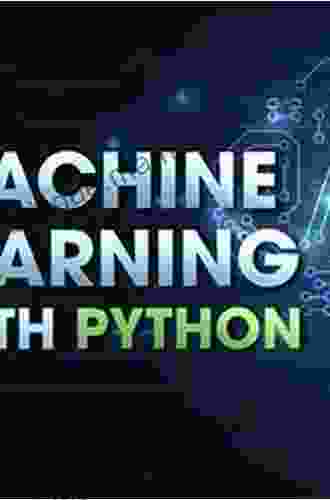Machine Learning for Time Series Forecasting with Python: A Comprehensive Guide

4.2 out of 5
| Language | : | English |
| File size | : | 16832 KB |
| Text-to-Speech | : | Enabled |
| Screen Reader | : | Supported |
| Enhanced typesetting | : | Enabled |
| Print length | : | 370 pages |
Time series forecasting is a crucial aspect of data science, enabling us to predict future values based on historical data. Machine learning (ML) algorithms play a pivotal role in this field, offering powerful techniques to extract meaningful patterns and make accurate predictions.
In this comprehensive guide, we will explore the fundamentals of machine learning for time series forecasting with Python. We will cover various concepts, algorithms, and techniques to help you build and evaluate predictive models for real-world applications.
1. Understanding Time Series Data
Time series data is a sequence of observations recorded at regular intervals, such as hourly temperature readings or daily stock prices. This data exhibits temporal dependence, meaning the value at any given time is influenced by past values.
To understand time series data, we need to consider the following characteristics:
- Trend: The overall direction or pattern of the data over time.
- Seasonality: Regular fluctuations that occur over a specific period, such as daily or monthly patterns.
- Cycles: Long-term fluctuations in the data that repeat over a longer period, such as economic cycles.
- Noise: Random fluctuations that do not follow any discernible pattern.
2. Machine Learning for Time Series Forecasting
Machine learning algorithms can learn from historical time series data to make predictions about future values. These algorithms leverage statistical and mathematical techniques to identify patterns and relationships in the data.
Common machine learning algorithms for time series forecasting include:
- **Autoregressive Integrated Moving Average (ARIMA):** A powerful statistical model that combines autoregression, differencing, and moving average components.
- **Seasonal Autoregressive Integrated Moving Average (SARIMA):** An extension of ARIMA that accounts for seasonality.
- **Exponential Smoothing:** A simple and effective forecasting method that weights past observations exponentially.
- **Long Short-Term Memory (LSTM):** A type of recurrent neural network that is particularly effective for modeling long-term dependencies.
- **Convolutional Neural Networks (CNNs):** A type of deep learning model that can learn spatial relationships in time series data.
3. Building a Time Series Forecasting Model
To build a time series forecasting model, we typically follow the following steps:
- Data Preparation: Clean the data, handle missing values, and convert it into a format suitable for the ML algorithm.
- Feature Engineering: Create additional features that may enhance the model's predictive power.
- Model Selection: Choose an appropriate ML algorithm based on the characteristics of the data and the desired forecast horizon.
- Model Training: Fit the ML algorithm to the historical data using a training dataset.
- Model Evaluation: Assess the model's performance on a holdout dataset using metrics such as mean absolute error (MAE) or root mean squared error (RMSE).
- Model Deployment: Implement the model in a production environment to make predictions on new data.
4. Evaluating Time Series Forecasting Models
Evaluating the performance of time series forecasting models is crucial to ensure their reliability and accuracy. Common evaluation metrics include:
- Mean Absolute Error (MAE): The average absolute difference between the predicted values and the actual values.
- Root Mean Squared Error (RMSE): The square root of the average squared difference between the predicted values and the actual values.
- Mean Absolute Percentage Error (MAPE): The average absolute percentage error, calculated as the mean of the absolute percentage errors for each prediction.
- R-Squared: A statistical measure that represents the proportion of variance in the actual values that is explained by the model.
5. Applications of Time Series Forecasting
Machine learning for time series forecasting has numerous applications in various industries and domains, including:
- Financial Forecasting: Predicting stock prices, currency exchange rates, and economic indicators.
- Demand Forecasting: Estimating future demand for products or services to optimize inventory management and production planning.
- Energy Forecasting: Predicting electricity demand, renewable energy generation, and energy prices.
- Healthcare Forecasting: Predicting patient outcomes, disease outbreaks, and healthcare resource utilization.
- Weather Forecasting: Predicting temperature, precipitation, and other weather conditions.
6.
Machine learning is a powerful tool for time series forecasting, enabling us to make accurate predictions about future values based on historical data. By understanding the fundamentals and techniques covered in this guide, you can build and evaluate predictive models for various real-world applications.
Remember to consider the specific characteristics of your data, select appropriate ML algorithms, and meticulously evaluate the performance of your models to ensure reliable and accurate forecasting.
4.2 out of 5
| Language | : | English |
| File size | : | 16832 KB |
| Text-to-Speech | : | Enabled |
| Screen Reader | : | Supported |
| Enhanced typesetting | : | Enabled |
| Print length | : | 370 pages |
Do you want to contribute by writing guest posts on this blog?
Please contact us and send us a resume of previous articles that you have written.
 Top Book
Top Book Novel
Novel Fiction
Fiction Nonfiction
Nonfiction Literature
Literature Paperback
Paperback Hardcover
Hardcover E-book
E-book Audiobook
Audiobook Bestseller
Bestseller Classic
Classic Mystery
Mystery Thriller
Thriller Romance
Romance Fantasy
Fantasy Science Fiction
Science Fiction Biography
Biography Memoir
Memoir Autobiography
Autobiography Poetry
Poetry Drama
Drama Historical Fiction
Historical Fiction Self-help
Self-help Young Adult
Young Adult Childrens Books
Childrens Books Graphic Novel
Graphic Novel Anthology
Anthology Series
Series Encyclopedia
Encyclopedia Reference
Reference Guidebook
Guidebook Textbook
Textbook Workbook
Workbook Journal
Journal Diary
Diary Manuscript
Manuscript Folio
Folio Pulp Fiction
Pulp Fiction Short Stories
Short Stories Fairy Tales
Fairy Tales Fables
Fables Mythology
Mythology Philosophy
Philosophy Religion
Religion Spirituality
Spirituality Essays
Essays Critique
Critique Commentary
Commentary Glossary
Glossary Bibliography
Bibliography Index
Index Table of Contents
Table of Contents Preface
Preface Introduction
Introduction Foreword
Foreword Afterword
Afterword Appendices
Appendices Annotations
Annotations Footnotes
Footnotes Epilogue
Epilogue Prologue
Prologue Nicolas Billon
Nicolas Billon Brooks D Kubik
Brooks D Kubik Adam Sappington
Adam Sappington Jeff Hertzberg
Jeff Hertzberg Doug Stanton
Doug Stanton Layla Hagen
Layla Hagen Anne Bishop
Anne Bishop Rachel Benge
Rachel Benge J J Clarke
J J Clarke Lucille Clifton
Lucille Clifton Karen Macinerney
Karen Macinerney Gillian Bickley
Gillian Bickley Becca Lee Gardner
Becca Lee Gardner Becky Rapinchuk
Becky Rapinchuk Renata Ramalli
Renata Ramalli Cindy Adkins
Cindy Adkins Darren O Donnell
Darren O Donnell Adam Mickiewicz
Adam Mickiewicz Toni Morrison
Toni Morrison Laura Stack
Laura Stack
Light bulbAdvertise smarter! Our strategic ad space ensures maximum exposure. Reserve your spot today!

 Chase MorrisUnderstanding Crohn's Disease and Ulcerative Colitis: A Comprehensive Guide...
Chase MorrisUnderstanding Crohn's Disease and Ulcerative Colitis: A Comprehensive Guide...
 Charlie ScottReturn to Lighthouse Point Charming Inn: A Haven of Tranquility and Coastal...
Charlie ScottReturn to Lighthouse Point Charming Inn: A Haven of Tranquility and Coastal... Floyd PowellFollow ·10.4k
Floyd PowellFollow ·10.4k Matt ReedFollow ·14.2k
Matt ReedFollow ·14.2k J.R.R. TolkienFollow ·9.7k
J.R.R. TolkienFollow ·9.7k D'Angelo CarterFollow ·9.3k
D'Angelo CarterFollow ·9.3k Derrick HughesFollow ·10.6k
Derrick HughesFollow ·10.6k Marvin HayesFollow ·17k
Marvin HayesFollow ·17k Henry HayesFollow ·14k
Henry HayesFollow ·14k Tim ReedFollow ·12.1k
Tim ReedFollow ·12.1k

 Dan Henderson
Dan HendersonPaper Blood: Two of the Ink Sigil
By D.S. Otis In...

 Joseph Conrad
Joseph ConradStarting Up: Critical Lessons from 10 New Schools
Starting a new school...

 William Powell
William PowellThe Peculiar World of Funny Science Fiction Comedy: Where...
Prepare yourself for an...

 Edgar Hayes
Edgar HayesUkulele Songs for Beginners: A Comprehensive Guide to...
Embark on a musical journey with the...

 Ralph Turner
Ralph TurnerDogs vs. Chickens: A Comprehensive Guide to Choosing the...
Dogs and chickens are both popular...
4.2 out of 5
| Language | : | English |
| File size | : | 16832 KB |
| Text-to-Speech | : | Enabled |
| Screen Reader | : | Supported |
| Enhanced typesetting | : | Enabled |
| Print length | : | 370 pages |










